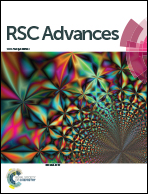Factors influencing the photocatalytic hydroamination of alkynes with anilines catalyzed by supported gold nanoparticles under visible light irradiation†
Abstract
The addition of an N–H bond to C![[triple bond, length as m-dash]](https://www.rsc.org/images/entities/char_e002.gif) C triple bonds in the hydroamination of alkynes is of great importance in synthetic chemistry. We found that visible light irradiation can efficiently drive the direct hydroamination of alkynes using supported gold nanoparticles (AuNPs) due to its Localized Surface Plasmon Resonance (LSPR). Au NPs on nitrogen-doped TiO2 could successfully induce hydroamination with a very high conversion (90%) and excellent product selectivity (91% imine product). Herein, we demonstrate that for such a photocatalytic process, the intensity and wavelength of the incident light, as well as the reaction temperature have a significant impact on the performance of the catalyst. The photocatalytic activity increases with increasing light intensity and reaction temperature. This means that the AuNP photocatalysts couple both the input light energy and thermal energy to catalyze the reaction. The influence of AuNPs and the surface properties of the support materials on the photocatalytic performance are also further discussed.
C triple bonds in the hydroamination of alkynes is of great importance in synthetic chemistry. We found that visible light irradiation can efficiently drive the direct hydroamination of alkynes using supported gold nanoparticles (AuNPs) due to its Localized Surface Plasmon Resonance (LSPR). Au NPs on nitrogen-doped TiO2 could successfully induce hydroamination with a very high conversion (90%) and excellent product selectivity (91% imine product). Herein, we demonstrate that for such a photocatalytic process, the intensity and wavelength of the incident light, as well as the reaction temperature have a significant impact on the performance of the catalyst. The photocatalytic activity increases with increasing light intensity and reaction temperature. This means that the AuNP photocatalysts couple both the input light energy and thermal energy to catalyze the reaction. The influence of AuNPs and the surface properties of the support materials on the photocatalytic performance are also further discussed.


 Please wait while we load your content...
Please wait while we load your content...